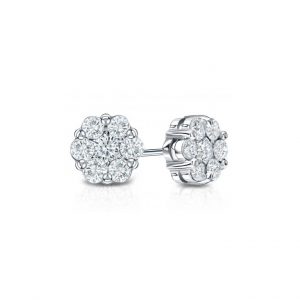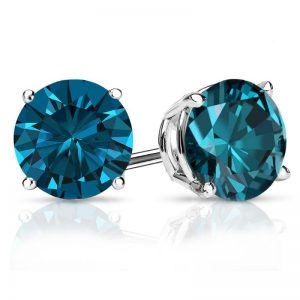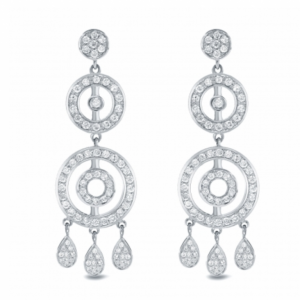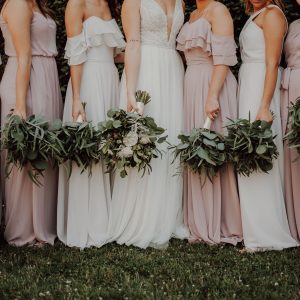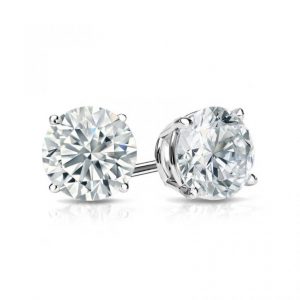
Diamond hoop earrings are a jewelry classic. They’re gorgeous, chic, and come in many different styles to suit your tastes. Which style is right for you? Find out in our ultimate guide to diamond hoops.
1. Diamond Hoop Sizes
Diamond hoop earrings come in so many sizes. There are hoops small enough to hug your earlobe, hoops that are several inches wide, and multiple sizes in between. Which size should you choose? Let’s take a look at your options and talk a bit about the advantages of each size.
Huggie Diamond Hoops
The smallest type of diamond hoop earring is the huggie. This ultra small hoop gets its name from the fact that it’s so small, it hugs your earlobe. Huggie diamond hoops are often set with petite pave diamonds, which gives them a delicate look. Huggie diamond hoops also tend to be wider than larger diamond hoops, which helps this small style stay visible from far away.
Huggie diamond hoops are an excellent everyday diamond hoop option. They look chic and add a touch of dainty brilliance to your ensemble. Since they’re a subtle style, they’re also appropriate for all occasions, so you’ll likely get a lot of wear out of a pair of huggie diamond hoops.

Small Hoops
Next up, we have the small diamond hoop earring category, which covers hoops that are around 8mm to 13mm in diameter. This size of hoop rests close to your ear, yet is far enough away to avoid hugging it.
Small hoops are one of the most popular sizes for diamond hoops. This style of hoop is quite classic and has a traditional, elegant look. They’re noticeably beautiful, yet still understated and sophisticated.
Medium Diamond Hoops

Medium diamond hoops range from around 14mm to 40mm in diameter. Medium diamond hoops are upscale and dressy, yet they work with both casual and formal outfits. A pair of medium diamond hoops can elevate a casual outfit or complement the elegance of a cocktail or black tie look.
As a general rule, slimmer medium diamond hoops with lower carat diamonds work best with more casual looks, while wider medium diamond hoops with higher carat diamonds work best with the glamour of a formal ensemble.
Large Diamond Hoops

Large diamond hoops are hoops that are over 40mm in diameter. Though, these hoops are so sizable, you may see their measurements listed in inches.
Large diamond hoops look excellent with upscale attire, as they’re a glamorous, statement-making accessory. Note that large diamond hoops often look best with an updo, like a sleek ponytail or a chignon. Wearing your hair up allows large diamond hoops to take focus and truly shine.
2. Prongs and Diamond Hoops
Prongs are what hold your hoop’s diamonds firmly in place. While prongs are a functional part of your earrings, they can also switch up the style of your hoops. Let’s take a look the four most popular prong styles used in diamond hoop earrings.
Standard Prongs
First up, we have the standard prong setting. In a standard prong setting, each diamond is held in place by several tiny pieces of metal. Prong settings can use four prongs per diamond but you can also find six prong and three prong settings (the latter of which is also known as a martini setting). Standard prong settings are one of the most common settings used by jewelers, so you’ll find many types of diamond jewelry use prong settings. While all types of standard prong settings are used for diamond engagement rings, diamond studs, and diamond drop earrings, diamond hoop earrings tend to mostly feature the four prong setting design.
Hoop earrings with standard prongs have a chic, classic look. Additionally, the design of a classic prong setting allows for maximum light entry. With this design, diamonds can catch light from both their tops and sides, making the diamonds highly brilliant.
Shared Prongs
Shared prongs operate like standard prongs, except neighboring diamonds share their setting. This style can give diamond hoops a higher overall brilliance, as there is a lower prong to diamond ratio. Also, this style can create an intricate look when used in certain ways. If the prongs used in hoops are arranged between each diamond vertically, rather than on the side of the hoops, the curves of round cut diamonds will create a pretty, scalloped effect.
Channel Settings
A channel setting holds your diamonds in place just like prongs do, but it works differently. In a channel setting, diamonds are placed snugly against one another in a line within your hoops. Then, that line of diamonds is kept secure with edges of metal.
Channel settings give diamond hoops a sleek, sophisticated look. This style of setting is excellent for those seeking a more modern, polished aesthetic.
Pave Prong Settings
Diamond hoops that feature small, delicate diamonds often utilize the pave setting. In a pave setting, diamonds are held in place by small beads of metal. This setting allows lines of petite diamonds to shine beautifully, without being overwhelmed by the size of larger, standard prongs. This setting gives the diamonds room to shimmer beautifully, creating delicate brilliance.
A Note on Less Common Setting Styles for Diamond Hoops
While the four types of settings covered above are the most common for diamond hoops, you will sometimes find hoops made with other settings, such as the bezel setting. Bezel settings are settings that hold diamonds in place with a ring of solid metal. This type of setting provides a sleek look and high protection against bumps and drops. While this is a popular engagement ring setting, it’s less popular for hoops, as it covers up much of the diamonds, reducing brilliance. Additionally, hoops are less at risk of getting bumped when compared to engagement rings or other diamond rings. So bezel settings tend be a less common choice for diamond hoops, as they offer fewer advantages when used for diamond hoops versus other type of diamond jewelry.
3. Diamond Color, Cut, and Clarity in Diamond Hoops
Now, let’s cover quality and diamond hoops. Unlike with an engagement ring or diamond studs, it’s rare to be able to select the diamonds within your hoops. Instead, diamond hoops are generally pre-made with an array of diamond gemstones that are similar in quality and carat.
What kind of quality should you look for when selecting diamond hoops? Earrings are something that are usually viewed from a distance when worn. So, often, people are happy to go a bit lower in the quality department in order to get hoops featuring larger diamonds. The same is true for diamond stud earrings, diamond drop earrings, diamond chandelier earrings, and many other types of diamond earrings. However, you shouldn’t go too low in quality for diamond hoops, diamond studs, diamond drop earrings, or other diamond earring styles, and we’ll share why.
Though the diamonds in hoops are viewed from a distance, you still want them to sparkle and look beautiful. So, for example, let’s talk about clarity. Clarity is often considered one of the Four Cs you can go a bit lower with, especially if you’re buying a diamond with a brilliant cut (like the round brilliant diamonds most often sold in hoops). However, when diamonds have a very low clarity, this can actually affect their sparkle, as the presence of many blemishes and inclusions can disrupt light reflection. So you may want to go with diamonds that are graded around SI clarity or higher.
Then, there are the other two quality-connected 4Cs: color and cut. Diamond cut, the measurement of how well a diamond was cut, is always important for brilliance. So you may want to make sure your diamonds are well cut and graded at least Good or better if you want your diamond earrings to shine brightly. Diamond color, the measurement of how colorless a white diamond is, is mostly a matter of personal preference. If diamond color is important to you, we’d recommend going with a near colorless diamond or higher, which includes diamonds with a J color grade and above.
If you care less about color and want to go with diamonds lower than a J color grade to get a better value, here’s a tip: choose yellow gold or rose gold settings over platinum or white gold settings. White gold and platinum settings tend to make color in a diamond more noticeable, due to contrast. While, on the other hand, the precious metals yellow gold and rose gold have warmer tones, which helps mask a bit of diamond color.
4. Diamond Shapes and Diamond Hoops
Finally, we’ll close out our ultimate guide to buying diamond hoops with some information on diamond shapes. If you’ve ever shopped for diamond hoops, you may have noticed that most diamond hoops feature round brilliant cut diamonds. Then, the second most common diamond shape for hoops is the princess cut diamond.
These two shapes are most often used in diamond hoops for three reasons: style preferences, setting styles, and brilliance. Both round diamonds and princess cut diamonds are extremely popular diamond shapes. Round diamonds are usually the top choice for those who want a classic look and princess cut diamonds are usually the top choice for those who want a modern, contemporary look. Then, both round and princess diamonds are very versatile when it comes to setting styles. Both of these styles fit into many types of prongs and earring settings, which makes it easy for jewelers to set diamond hoops with them. Lastly, there’s the issue of brilliance. The round brilliant diamond is the most brilliant diamond shape by far and princess cut diamonds are also quite brilliant. This is an advantage for diamond hoops because, usually, people want them to sparkle brightly even from a distance.
You will sometimes find diamond hoop earrings with oval, cushion cut, emerald cut, baguette cut, and asscher cut diamonds. Then, rarely, you may see diamond hoops with pear shaped, marquise cut, or heart shaped diamonds. But these fancy shaped diamonds tend to be less popular for diamond hoops, so you’ll see them used much less often than round and princess cut diamonds.
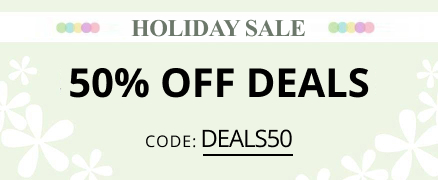






 1-855-969-7883
1-855-969-7883 info@diamondstuds.com
info@diamondstuds.com




